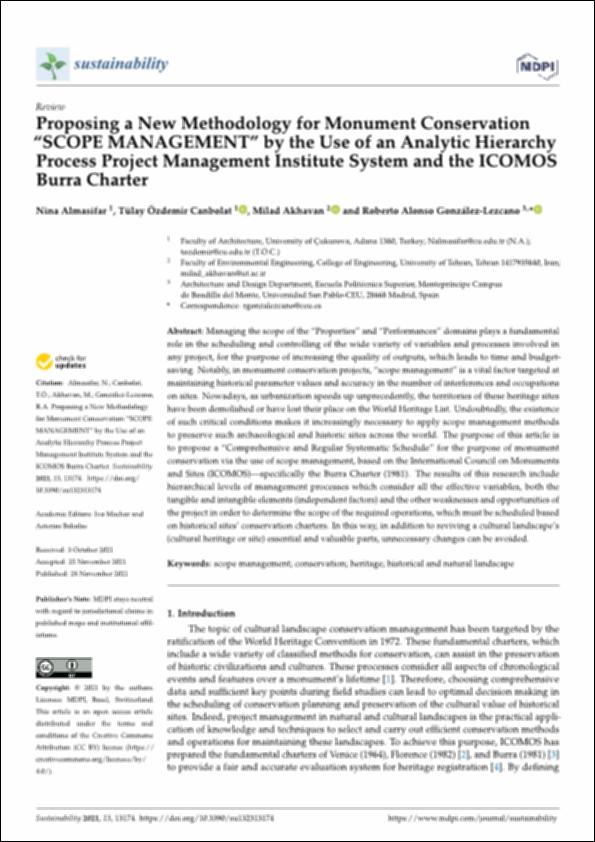Por favor, use este identificador para citar o enlazar este ítem:
http://hdl.handle.net/10637/14557Proposing a New Methodology for Monument Conservation “SCOPE MANAGEMENT” by the Use of an Analytic Hierarchy Process Project Management Institute System and the ICOMOS Burra Charter
| Título : | Proposing a New Methodology for Monument Conservation “SCOPE MANAGEMENT” by the Use of an Analytic Hierarchy Process Project Management Institute System and the ICOMOS Burra Charter |
| Autor : | Almasifar, Nina. Özdemir Canbolat, Tülay Akhavan, Milad González Lezcano, Roberto Alonso. |
| Materias: | Scope management; Conservation; Heritage; Historical and natural landscape |
| Editorial : | MDPI |
| Citación : | Almasifar, N.; Canbolat, T.Ö.; Akhavan, M.; González-Lezcano, R.A. Proposing a New Methodology for Monument Conservation “SCOPE MANAGEMENT” by the Use of an Analytic Hierarchy Process Project Management Institute System and the ICOMOS Burra Charter. Sustainability 2021, 13, 13174. https://doi.org/ 10.3390/su132313174 |
| Resumen : | Managing the scope of the “Properties” and “Performances” domains plays a fundamental role in the scheduling and controlling of the wide variety of variables and processes involved in any project, for the purpose of increasing the quality of outputs, which leads to time and budgetsaving. Notably, in monument conservation projects, “scope management” is a vital factor targeted at maintaining historical parameter values and accuracy in the number of interferences and occupations on sites. Nowadays, as urbanization speeds up unprecedently, the territories of these heritage sites have been demolished or have lost their place on theWorld Heritage List. Undoubtedly, the existence of such critical conditions makes it increasingly necessary to apply scope management methods to preserve such archaeological and historic sites across the world. The purpose of this article is to propose a “Comprehensive and Regular Systematic Schedule” for the purpose of monument conservation via the use of scope management, based on the International Council on Monuments and Sites (ICOMOS)—specifically the Burra Charter (1981). The results of this research include hierarchical levels of management processes which consider all the effective variables, both the tangible and intangible elements (independent factors) and the other weaknesses and opportunities of the project in order to determine the scope of the required operations, which must be scheduled based on historical sites’ conservation charters. In this way, in addition to reviving a cultural landscape’s (cultural heritage or site) essential and valuable parts, unnecessary changes can be avoided. |
| URI : | http://hdl.handle.net/10637/14557 |
| Derechos: | http://creativecommons.org/licenses/by-nc-nd/4.0/deed.es openAccess |
| Fecha de publicación : | 28-nov-2021 |
| Centro : | Universidad San Pablo-CEU |
| Aparece en las colecciones: | Escuela de Politécnica Superior |
Los ítems de DSpace están protegidos por copyright, con todos los derechos reservados, a menos que se indique lo contrario.


